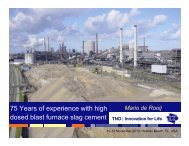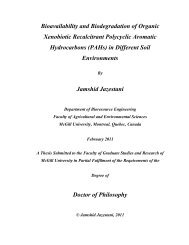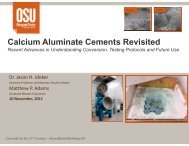i THERMAL PROCESSING EFFECTS ON TOTAL ... - McGill University
i THERMAL PROCESSING EFFECTS ON TOTAL ... - McGill University
i THERMAL PROCESSING EFFECTS ON TOTAL ... - McGill University
Create successful ePaper yourself
Turn your PDF publications into a flip-book with our unique Google optimized e-Paper software.
and flavonols, together with trans-resveratrol-3-O-glucoside, as well as higher<br />
concentrations of proanthocyanidins are found in the seed coat, whereas non-flavonoid<br />
phenolics compounds are mainly located in the cotyledons (Dueñas et al., 2002).<br />
Ames et al., (1983) reported that the majority of antioxidants from lentils were<br />
phenolics and polyphenols. In lentil seeds, most phenolics, both in terms of quantity and<br />
variety are located in the seed coat. Therefore, the seed coat of lentil-like legumes, which<br />
represents only a small percentage (8-11% dwb) of their total seed weight could be used<br />
as a replacement for synthetic antioxidants (Ronzio et al., 1998). Lentils have the highest<br />
phenolic, flavonoid and tannin contents (6.56 mg GAE g -1 ; 1.30 and 5.97 catechin<br />
equivalents g -1 , respectively) compared to other common beans and pulses (Xu and<br />
Chang, 2007). An optimum antioxidant activity (95%) was obtained when the radical<br />
scavenging activity of a lentil extract was evaluated by using 1, 1-diphenyl-2-picrylhydrazyl<br />
(DPPH) (Halvorsen and Holte, 2002). The phenolic antioxidant activities of legumes are<br />
related to the compounds‘ structure, for example, for the primary antioxidants flavonoids<br />
(Decker, 1997), their antioxidant activity is associated with the position and degree of<br />
hydroxylation (Rice-Evans et al., 1996). According to Xu and Chang (2007), lentils and<br />
red beans are rich sources of tannins. They found the highest amounts of tannins in lentils,<br />
where they ranged in content from 0.12–8.78 mg catechins equivalents g -1 . According to<br />
Fernandez-Orozco et al., (2003), the content of α- tocopherols in lentils ranges from<br />
3.84–8.69 mg g -1 dwb.<br />
2.7 Conclusion:<br />
Consumer interest and health concerns for natural and ready-to-cook pulse<br />
ingredients have recently come into demand. Though lentil-like legumes are rich in<br />
proteins, antioxidant activity, some of their nutritional components reduced their<br />
usefulness as human food with respect to the recommended intake of certain nutrient<br />
levels. Therefore, the use of traditional processing methods such as boiling and roasting,<br />
along with newer electro-technologies such as microwave heating, were applied to the<br />
processing of lentil flours. These methods‘ affect with regards to improving the<br />
30









